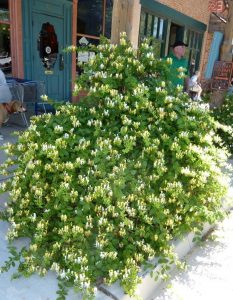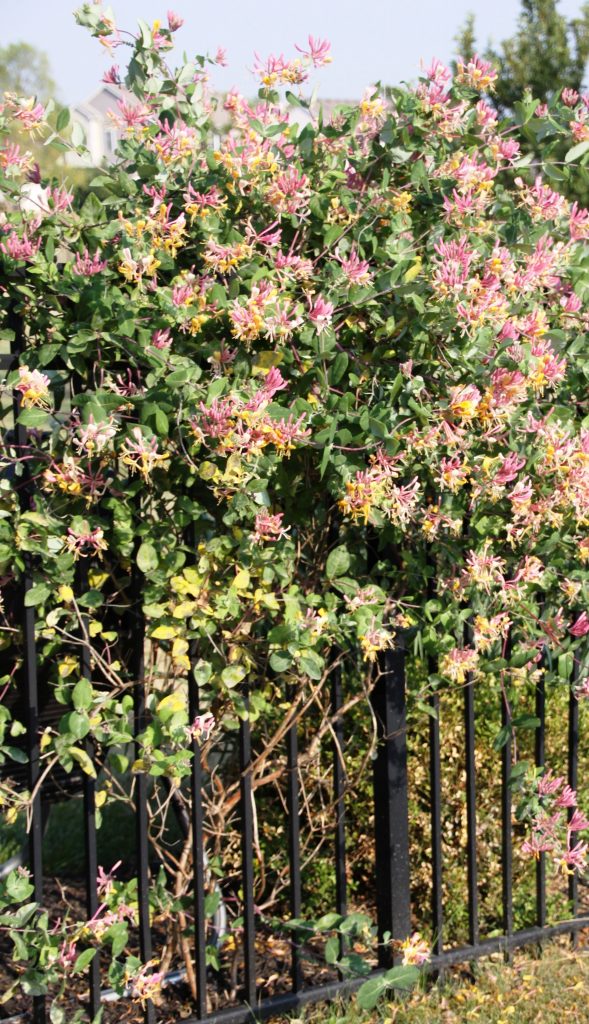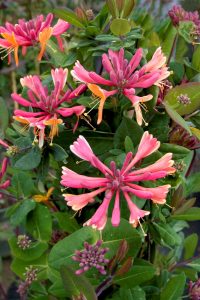by Ken Lain, the mountain gardener
An excellent vine to use as a cover for trellis, arbor, and fencing. Also works well when pruned to form a dense shrub-like shape. Purple to deep pink buds open to sweetly fragrant, golden yellow, tubular flowers throughout summer.

Honeysuckle (Lonicera japonica) is an extremely vigorous perennial vine that is often evergreen through winter. It is prized for its long bloom period and fragrant flowers that bloom all summer and into autumn.
Honeysuckle vine is a climber that twines thickly around any vertical structure, whether it is a trellis or a tree. The vines bear fragrant white flowers, tinged with pink, that attracts butterflies and hummingbirds from late spring into fall. The flowers gradually fade to yellow, and it is not uncommon to see white, pink, and yellow colors all at the same time. The flowers give way to blackberries. The vine is often planted because it does well in shady locations and in super dry soils.
Botanical Name Lonicera japonica
Common Names Japanese honeysuckle, golden-and-silver Honeysuckle, Japanese Honeysuckle weed
Plant Type Perennial flowering vine
Mature Size 15-20′ feet in length x spread of 3-6 feet
Sun Exposure Full sun to part shade
Soil Type Prefers average soil that is well drained
Soil pH 5.5 to 8
Bloom Time Late spring to fall
Flower Color White, maturing to yellow
Hardiness Zones 4 to 9 (USDA)
Native Areas Eastern Asia including China, Japan, and Korea
How to Grow Honeysuckle
Although Japanese Honeysuckle prefers moist, loamy soils, these ideal conditions can cause the plant to grow too vigorously. It does well in dry, dusty conditions. Plant it in full sun to part shade; shadier locations will reduce the amount of flowering and stunt the plant’s growth.
When trained on a trellis, a single plant is typically used. When planted as a ground cover, use a plant per square yard of ground. Ground cover plants should be sheared back with a lawnmower in later winter to control growth and remove any dead undergrowth.
Light
This is an adaptable plant that does well in full sun to part shade, but a shadier location is sometimes preferred to keep its growth in check.
Soil
Honeysuckle does well in any soil so long as it drains. Dryer soils may limit the dense growth habit of the vine.
1.Dig hole 2-3 times the width of the container but the same depth.
2. Score the root ball sides and bottom with a utility knife or pruners and place in the planting hole.
3. Blend Watters Premium Mulch into the native soil at 1 part mulch with two parts soil dug from the hole and pack firmly around the roots.
4. Sprinkle 7-4-4 All Purpose Plant Food around the planting area.
5. Prevent ‘Transplant Shock’ by adding Watters “Root & Grow” to your water at 2-week cycles for the first 2 months.
6. Use remaining Watters Mulch inside the tree well as a top dressing. This will keep weeds down, insulate roots from heat and cold, and keep the roots moist.

How to Water
Always water your newly planted grass thoroughly after transplanting. The roots require plenty of moisture to recover from the stress of the transplant. Failing to water your pampas grass could stunt its growth.
Ensure that you keep the soil uniformly moist. Push your finger an inch into the soil. If it feels moist, then your grass is fine. However, if it’s dry, it means that the roots aren’t getting the moisture they need.
How to Feed for Showy Honeysuckle
During the first year after planting, fertilize Honeysuckle in the early spring, summer, and fall with 7-4-4 All Purpose Plant Food. It can take up to 3-years for small Honeysuckle to establish itself and bloom properly.
Propagating Honeysuckle
This plant is rarely propagated deliberately due to its aggressive growth habit. It is easily propagated by planting seeds from the berries or splitting off sections of its spreading rhizomatous roots.
Varieties of Honeysuckle
The variety of Honeysuckle most often planted for landscape purposes is ‘Halliana’, commonly called Hall’s Honeysuckle.
Toxicity of Japanese Honeysuckle
Many species of Honeysuckle are toxic to one degree. This plant contains carotenoids in the berries and glycosides in the stems and vines. These are considered mildly toxic, and symptoms can include stomach pain, diarrhea, irregular heartbeat, and vomiting. But the effects are usually mild and occur only when large quantities are ingested. The plant does attract butterflies and hummingbirds, and many birds enjoy eating the berries.

Pruning
Major pruning should be done in the early winter after the flowers have dropped off. Pruning usually aims at shortening the plant and keeping its size in check. Plants grown as ground cover should be mowed down in March with a mower set at maximum height.
Alternative Vines
Honeysuckle’s other forms offer some of the same benefits but without the dangerously dense growth habit of Honeysuckle. Some options include:
Goldflame honeysuckle (Lonicera heckrottii) is a deciduous vining plant hardy in zones 5 to 9. It has fragrant flowers growing to 15 to 20 feet that are hot pink with yellow throats, blooming from late spring through mid-summer.
Dropmore scarlet honeysuckle (Lonicera brownii) is hardy in zones 3 to 9. It is a smaller vine, growing to 12 feet, and produces fragrant bright red flowers from late spring through mid-summer.
Trumpet honeysuckle (Lonicera sempervirens) is a semi-evergreen vine that is hardy in zones 4 to 10. It grows to 12 feet and has bright orange, red or yellow, tubular flowers from late spring to mid-summer.
Henry’s Honeysuckle (Lonicera henry) is hardy in zones 4 to 10. It grows to 30 feet and has red or yellow tubular flowers through spring and summer.
American Honeysuckle (Lonicera americana) is hardy in zones 6 to 10 and grows to 25 feet. It has scented yellow flowers tinged with red, pink, or purple from late spring into fall.
Winter honeysuckle (Lonicera fragrantissima) is a semi-evergreen shrub form that grows to 10 feet tall with a similar spread. It is hardy in zones 4 to 8. It has pairs of small, creamy white, fragrant flowers from late winter through mid-spring.
Common Pest and Diseases
Honeysuckle is largely without severe insect and disease problems, as befits a vine with a reputation for being so vigorous. Deer, Rabbit, Elk, and Javelina all leave this pretty plant alone.

